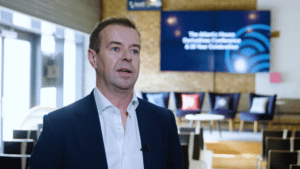Rethinking the balanced portfolio with convertible bonds
Not only is 2020 the marking of a new decade, but it potentially marks of a new paradigm of investing. The last 30 years shouldn’t have been that difficult for long-term investors and those using the traditional 40-60 balanced portfolio. The historic fall in interest rates that has occurred since the 1980s means that both the fixed income and equity components benefited from falling interest rates.
Yet as we look forward into the decade ahead, we have effectively reached the lower bound for interest rates, being zero. As a result, the tailwind of the last 30 years is gone. At this point, most experts around the world expect interest rates to be higher ten years from now, or even five. If this is correct, then the core premise of the traditional balanced portfolio, being to hold 40% in long-duration bonds, may well be broken.
It is becoming more difficult to justify holding such a large portion of a portfolio in an asset class that will almost certainly deliver a return that falls below a client return objective over the next five to ten years. So, what is the solution? Adviser, direct investors, and institutions alike have been flocking to non-traditional or ‘alternative’ assets. Effectively, these are asset classes that are not simply bonds or equities but may have the characteristics of both.
Interestingly, there is one asset class that does have the characteristics of both: global convertible bonds. While Australian investors would be accustomed to convertible preference shares or hybrids, these are very different beasts. One of the defining features of global convertible bonds is the fact that conversion is in the hands of the holder, not the issuer, as is the case in Australia. Put simply, convertible bonds pay an interest coupon to investors, usually quite low, but allow conversion into the underlying shares of the business at the holder’s request. This conversion is based on a pre-determined number of shares, effectively providing a floor for the bond price.
By far the global leader in the sector is French asset manager, Lazard, with the New York-based Arnaud Brillois having run the house’s dedicated strategy since 2008. If there were ever a specialist in a sector, it is Brillois. With a track record now spanning two major crises, the GFC and COVID-19, he highlights that the GFC was by far the worst condition for bonds and credit markets, but that convertibles performed well despite this.
The sector is seeing somewhat of a boom despite the difficult conditions in 2020. Brillois confirms that “convertible bond issuances have reached their highest levels since 2007, reaching US$101.8 billion ($145 billion) for the year to date.” Originating in the railroad boom of the 1800s, convertible bonds have been popular with fast-growing companies, with one fundamental objective according to Brillois: conserving liquidity. This theme has continued into the 2020s, with faster-growing mid-cap companies the most dominant convertible bond issuers. In general, these companies do not want to give up liquidity by taking on debt, or dilute themselves by issuing equity, when they are about to grow quickly. Convertibles therefore offer the best of both worlds to these firms.
On the perception that the sub-investment-grade nature of the securities means they are higher risk, Brillois says “it is true that the majority of convertibles are sub-investment-grade, but investors shouldn’t confuse this with unreasonably high risk.” He highlights the fact that the fast-growing and reasonably new nature of these businesses (and industries) means they simply wouldn’t be able to jump through the many hoops required of credit rating agencies (or have the time to do so), not that they are over-leveraged or likely to default.
Interestingly, on the subject of leverage, Brillois notes that “many convertible issuers refrain from issuing other forms of debt, they tend to have cleaner balance sheets than high-yield and even investment-grade issuers, as measured by risk ratios like free cashflow-to-debt and debt-to-EBITDA (earnings before interest, taxes, depreciation, and amortisation)” This is in stark contrast to many of the more popular credit strategies that have become available to investors.
Combine this with the fact that about 80% of convertible bonds rank as senior unsecured debt, and the risk of default is clearly better than rated ‘junk bonds’.
Why would investors be seeking to add an exposure to convertible bonds today? According to Brillois, “they tend to exhibit bond-like characteristics in declining equity markets, and equity-like characteristics in rising equity markets.” This couldn’t have been better demonstrated than in March and April 2020.
According to Lazard, “as the selloff started from the end of February to mid-March, convertible bonds became increasingly defensive, boosting their outperformance relative to equities but with a lower drawdown.” And what happened when the market started to rebound? “Convertible bonds quickly became more sensitive to equity prices and captured the rebound, maintaining a considerable outperformance relative to global equities”. The result was a 12.2% return to 31 August, compared to a 1.7% fall in the MSCI All Countries World Index (ACWI) and -2.7% in the Bloomberg High Yield Bond index.
This is probably the clearest confirmation of the “asymmetric payoff” that has driven dedicated allocations to the sector by a growing cohort of pension funds.
The team at Lazard uses Tesla as a real-world example, with the electric vehicles and batteries firm using convertible bonds extensively to fund its spectacular growth trajectory. Lazard highlights the volatility in 2017 through to today, during which the stock at one point fell by almost 30% as investors fretted over its profitability, but Tesla’s convertible bond fell by just 4.6% in the same period. By contrast, as the company has grown since, the convertible bond has returned 721%, compared to 877% for the equity, in the period to 31 August 2020.
Could global convertible bonds be the solution to the risk return conundrum facing Australian investors? The US$500 billion ($714 billion) asset class has clearly moved beyond ‘niche’ status, triggering the release of Lazard’s dedicated strategy to Australian investors for the first time.










